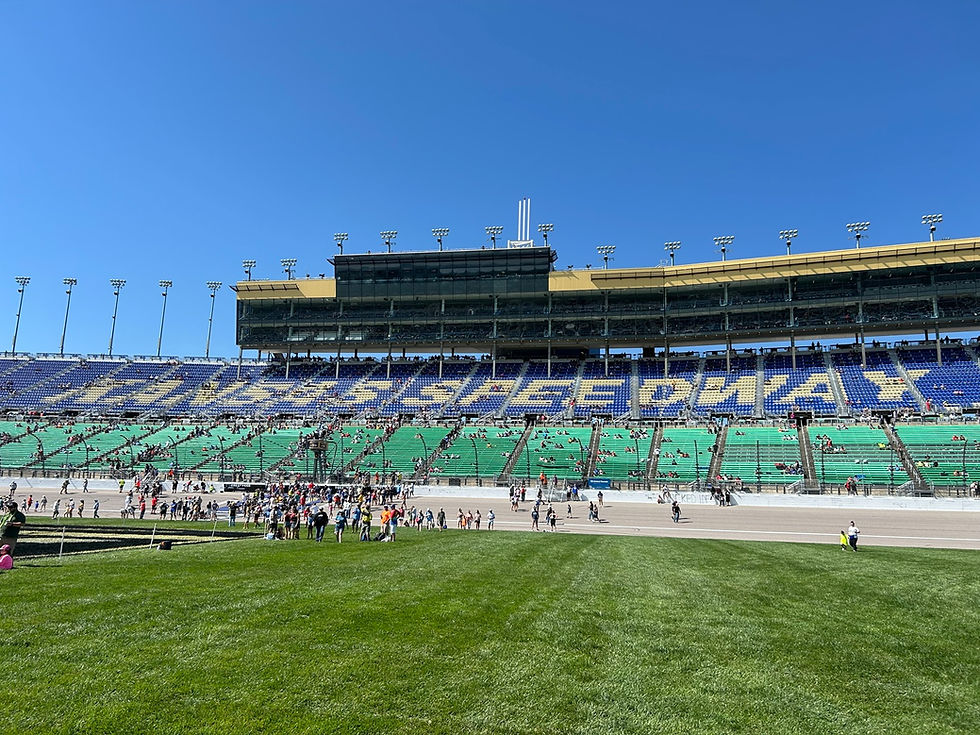Moto Polo - Organized Chaos & a Seven-Foot Rubber Ball
- Marc Viquez

- Oct 10
- 4 min read

If you think that Banana Ball and Cosmic Baseball have been spectacular at the ballpark this year, then you should see what was being offered to fans in 1950. Instead of watching soccer, football, and auto racing, why not combine all three and turn it into a new sport? The sport was moto-polo, and it was described as the world’s most daring and thrill-packed game ever presented on the racetrack.
Others called in 2 hours or rolling suicide, and the home of a thousand spills and hundreds of roll-overs. It was a sport designed for early TV sets in the Los Angeles area, to present an idea crazy enough that people would pay to see at their local racetrack and speedway.
On April 16, 1950, at the Kern County Fairgrounds, fans witnessed the first contest featuring moto-polo. Here, two teams of three specialty-built cars faced off, each trying to push a 200-pound ball—measuring 5 to 7 feet in height—down 100 yards to score a goal. These cars, capable of reaching speeds of 50 miles per hour, were equipped with large cages to protect drivers from injury during rollovers.

Adding to the spectacle, a specialized, smaller referee vehicle with a siren was used. Like the other cars, it was encased in steel hoops enabling it to flip and right itself. The referee signaled penalties by firing a gun into the air, and for major infractions, a third car with a giant hook removed offending vehicles from the field.
“You can hear the emotion surge through the crowd when an unusually spectacular accident occurs,” said California Polo League secretary Gene Gach. “They love it! They gasp when parts fall off the cars! Once in a while, a petrol tank bursts and fuel catches fire. The crowd goes wild!”
That year also saw the formation of the California State Moto Polo League, which included four teams: the Los Angeles Red Devils, Hollywood Wolves, San Francisco Shamrocks, and Oakland Pirates. With games televised, 10,000 fans attended the inaugural contest at Washington Boulevard Stadium in Venice, California. A year later, new teams called the Sacramento Speedbusters, Stockton Skyrockets, and Oakland Thunderbirds entered the ring.
The majority of the vehicles were stripped down to 1935 and 1946 Ford V8 passenger cars that were covered by a framework of steel tubing to prevent them from rolling over or tipping end-to-end without injuring the driver, who was strapped to his seat belt. The drivers did not have harness belts at the time, and each car cost around $2,500 to build for the league.

The game would begin when a ball was put into play by a “smash off,” when a car struck the giant inflatable ball into the air and then back into play. An out-of-bounds ball would be put back into play by a “twist off” between two cars speeding towards one another in opposite directions.
There were also three-minute fouls in a penalty box, removal of players, and their version of a penalty kick called a free “smash” on the goal at mid stripe. There were bumps and bruises inside the car, but the spectators were more at risk for serious injuries from the stands.
Spectators had to keep their eyes on the action or suffer being hit by a flying tire, a ripped railing, or other car parts flying near or through the fencing. A bystander in Bakersfield was injured sitting on a rail near what officials deemed the “danger area.”

The next year, the show went on the road throughout the West Coast and other parts of the country. Games were held in Oregon, Nebraska, Iowa, Oklahoma, and Illinois. The majority were held at speedways, racetracks, county fairs, and minor league ballparks.
“Once in a while, we would get two (cars) on a side, ram him, pick him up, and drive him around the place,” former driver Jack Phillips said. “He’d scream at us to put him down, and he’d blow his whistle, but we just laughed. So would the fans.”
The events were advertised as a riot on wheels and mechanized mayhem. The events were held within a 2-hour time frame and featured half-time motorcycle stunt performers. Drivers signed autographs to a legion of fans after each game, and some were paid close to $250 a week.

However, by 1955, the once promising new sport had lost steam. Digging through the newspaper archives, there are more than plenty of black and white photos of the cars and rubber ball, some grainy and others very clear. The height was between 1950 and 1952, and with Hollywood stars such as Bob Hope and Bing Crosby painting the new sport, it seemed destined for coast-to-coast popularity.
According to former driver, Jack Phillips, the end was the Los Angeles County Fairgrounds. A car accidentally bumped into a TV tower, causing it to sway back and forth. Other drivers raced over and rammed their vehicles into the tower as a joke. The stunt backfired, causing thousands of dollars' worth of damage to the equipment. The TV station sued the drivers, and their cars were impounded, leading to the quick end of moto polo.
A ticket to see it live was around $1, and it appeared to be a fun-filled 2 hours of back flips, crashes, speed, and stunts. The sport enjoyed brief fame and made it into many newspapers across most of the country. Sadly, its fast rise ended just as quickly and is nearly forgotten 75 years after its debut. However, it might be time for a revival.
Check out a clip from the KTLA archives!
----
Follow all of Marc’s stadium journeys on Twitter @ballparkhunter and his YouTube channel. Email at marc@stadiumjourney.com







Comments